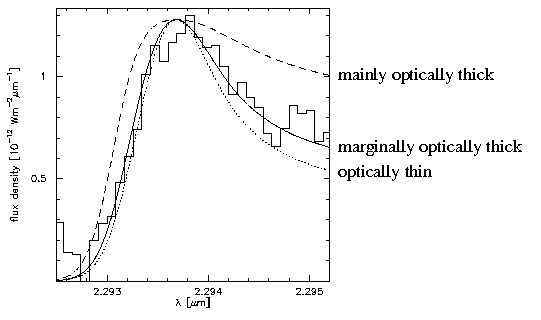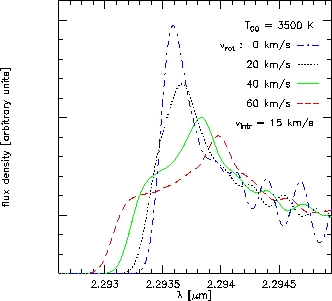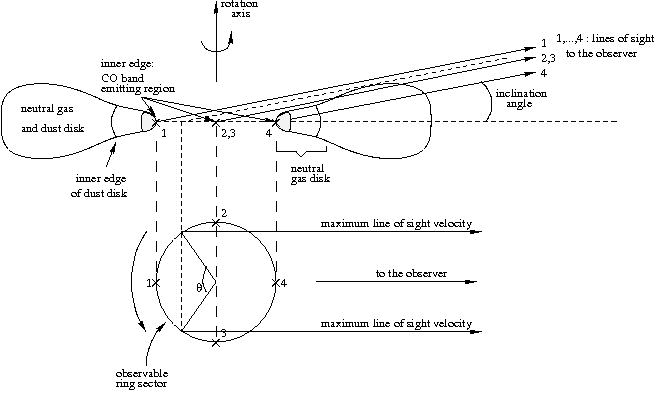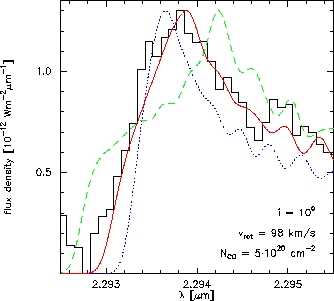In 1998 we had obtained high-resolution K-band spectra using the United Kingdom 3.8 m Infrared Telescope (UKIRT). The spectra covered the region of the first two CO band heads, and our aim was to determine from these high-quality data the physics and kinematics of the CO emitting region. In particular we were interested whether the CO gas is located within the Keplerian rotating disk, or whether the emission could also be generated within the dense stellar wind.
From the shape and ratio of the CO band heads we found that the CO gas has a temperature of 3500-4000 K and that the level population of the rotational-vibrational levels is close to LTE, indicating a high-density medium. Optical depth effects are present, confirming the reliability of the LTE assumption. The width of the first band head indicates a velocity broadening of 50-60 km/s. A fit to the first bandhead is shown by the solid line in the following figure, showing the influence of the optical depth on the band head structure. It is obvious that some marginal optical thickness of the CO emitting region is needed in order to reproduce the slope at the long wavelength end.

Interestingly, no obvious signature for Keplerian rotation (given by blue-shifted shoulder and red-shifted maximum as shown in the next figure) is visible in the band head structure. This could mean that the CO forming region is (i) indeed within the wind, for which other emission lines like those from the hydrogen Pfund series also deliver a Gaussian velocity of about 50 km/s, or (ii) at far distances in the disk, where the Keplerian rotation is already too low (i.e. smaller than 40 km/s) to produce the characteristic band head structure.

Detailed modeling revealed that both scenarios have problems in explaining the CO band heads observed from MWC 349: In the wind model the emitting CO gas would be located within the ionized region, i.e. within the H II region surrounding the hot central star. In such a harsh environment the CO molecules would suffer from dissociation by the stellar radiation field. Hence, the high density disk in which effects like self-shielding of CO easily protect the molecules from being dissociated is certainly the better location. However, given the narrow profile of the band head, we would have to place the CO emitting region to distances far away from the central star where the Keplerian rotation is low enough so that the characteristic shoulder structure of the band head is not formed. Using a maximum Keplerian rotation speed of 40 km/s, the CO emitting region would be located at a distance larger than about 14 AU. For comparison, the dust condensation distance that is the distance from the star at which the dust reaches its maximum temperature of about 1500 K lies at 2.9 AU. CO, which is much hotter than the dust, must thus be located at distances closer to the star than the inner edge of the dusty disk. This would mean, that CO must be located at distances where the Keplerian rotation of the disk is in excess of 90 km/s !
To overcome this dilemma, we therefore suggested a different scenario for the CO band emitting region: Because of the required high temperature and column density, the CO must be located inside the evaporation radius of the dust, i.e. at distances less than 2.9 AU from the star, and we adopt a Keplerian rotation of 100 km/s. Such a high rotation speed would immediately imply the shoulder structure of the CO band head. To avoid this, we make use of the almost edge-on orientation of the dusty disk, which we assume to flare (i.e. increase its height with distance). Consequently, the dust along the line of sight can absorb the CO emission and hence blocks all the emission from the near side of the inner ring. For illustration we show in the next figure the possible scenario for the disk around MWC 349.

Due to the shielding by the thick dusty disk we can only see the far side of the CO ring and hence we can only observe CO gas with radial velocities smaller than about 60 km/s. This CO emitting "sector" as seen from top is shown in the lower part of the figure, indicating the maximum observable line of sight velocity. With such a scenario in mind, we were able to reproduce fairly well the observed band head structure with a physically reasonable scenario. The final result is shown by the red line in the following figure. Assuming a Keplerian rotation velocity (projected to the line of sight) of 98 km/s, the observable sector of the CO emitting ring must have an opening angle of about 75 degrees. For comparison, we also included model computations for sectors with opening angles of 180 degrees (green line) and 33 degrees (blue line).

Although the proposed scenario was highly speculative at the time of publication of our results, we now know that many stars are surrounded by flared dusty disks. Hence, we still consider our model as physically reasonable but are aware of the fact that a final proof for its reliability in the case of MWC 349 is still missing.